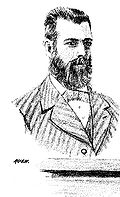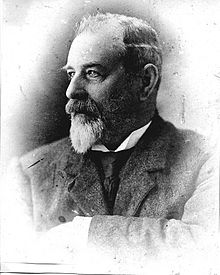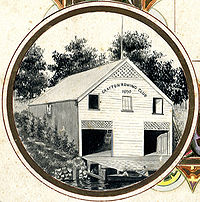- Michael Rush (rower)
-
Michael Rush (b. 1843 - d. 1922) was an Irish Australian sculler noted for his one-on-one competitions against champion opponents, which drew vast crowds of spectators.
Contents
Youth and Early Times
Rush was born on 3 January 1844 in Dooish, near Omagh, County Tyrone, in what is now Northern Ireland.[1][2] One of ten children, Michael and his brother John emigrated to Australia, arriving in Sydney per 'Hotspur' on 24 February 1861.[3] Their emigration had been sponsored by one Michael McGrath, and the boys went to work for employers on the Clarence River in the far north coast of New South Wales.
Rush was first a farm labourer, then assistant to a butcher, and later became a store-keeper. Rush became adept at rowing the heavy boats (known as 'butcher boats') used for delivering goods to customers along the river.[4] By 1869, Rush and his friend Prosper Coloun had often competed against each other in rowing races, and Rush had taken the title of 'Champion of the Clarence'. In 1865, the 'two raw farm boys' as Rush described himself and Coulon, boldly took part in the Anniversary Regatta in Sydney.[5]
Sculling career


Rush during his sporting days.[6] His rowing weight was about 12 st 7 lb to 12 st 10 lb (about 80 kg). His first match was against the late P. Colourn, whom he beat, but afterwards met with defeat several times from that sculler. He rowed for the first time in Sydney, at the regatta when he won two events; and the following month, he and Colourn defeated the brothers Trickett in a double sculling race, in skiffs. He was next beaten by the then champion, W. Hickey, in skiffs, who refused to row again in the same class of boats. But a match was rowed between Rush and R. Hickey, resulting in a victory for the first named. Rush then learned to row in outriggers, and on 19 November 1870, was beaten by 10 lengths, by W. Hickey, for £200 a side and the Australian championship. A month later, the same two rowed a match in skiffs, Rush winning. In 1873, they again met on the Parramatta, in outriggers, when Rush won by six lengths.
“Charon”, of the The Sydney Mail, 1883 wrote:
"Personally Rush is one of the best of good fellows. Possessing a fine, manly face, with cheery, pleasant expression, and being able to boast of just enough of his native brogue to swear by, he is a worthy specimen of a genial, good hearted Irishman. His height is 6 feet 1 inch, and as he will be only 38 next birthday, he may be considered comparatively a young man. His style of rowing is anything but taking to the eye, but, notwithstanding, he gets the pace out of his boat, What he lacks in skill is fully compensated for by the powerful frame and strong muscular development. He has not had the experience of his opponent, nor has he travelled the world wide in search of foemen, worthy of his steel, yet patiently and perseveringly he has entered the lists; and, lacking the skill and knowledge of his celebrated adversary with alternate success he has battled with him."
The following year, at Grafton, he beat Edward Trickett, Elias C. Laycock, Hickey, Green, and others; but at the Grafton Regatta, 1874, was beaten by Laycock and Solomon. In 1875, no response was made to a challenge of Rush's, to row any man in the world, for £500 a side, on the Clarence. When Trickett returned from England, after beating Joseph Sadler, Rush threw out another challenge, which resulted in the men rowing for the Championship of the World, the event being witnessed by 50,000 people. Rush led for about a mile, when Trickett went to the fore, and finished 10 seconds in front of his opponent.
In 1879 he was beaten by Laycock, on the Parramatta, in outriggers, but the finish was so close that the umpire's decision was questioned, Five months later Laycock beat him easily, over the same course. It was then said that Rush was not in good rowing form. After Laycock's return from England, Rush issued another challenge, and the pair met on the Parramatta in 1881, for £200 a side when the Clarence man won by 6 lengths, in 21 minutes the fastest time recorded over the champion course. It was immediately following this that his friends in Sydney presented him with plate to the value of £200, and entertained him at a banquet. He then rowed in the Walker Whiskey race, in which he was beaten by Pearce and Power his defeat being attributed to some defect in the boat used by him. Rush and Power again met, the former staking £200 to £100 with a similar result; but on the following Saturday Rush “turned the tables" on Power. Then on the following Monday, he also defeated Pearce; but two days later again succumbed to Laycock.
At the Grafton regatta in May 1882, he won the outrigger race very easily from Power, and his last appearance was in the Punch Trophy race in which he won both his divisions, beating Pearce, Laycock, and D. McDonald; and the final heat from Bill Beach, Trickett, and Laycock.'[7]
Founding of the Grafton Rowing Club
Business Enterprises and Later Life
In 1881, Rush sold his various businesses at 'Rocky Mouth' and moved to Grafton.
He later moved to Sydney, leasing and managing several hotels, finally retiring to a smallholding near Hurstville owned by his son, where he died, on 17 December 1922. Michael Rush was buried in Waverly Cemetery.
Rush Lane, 29°27′8.7″S 153°11′57.34″E / 29.452417°S 153.1992611°ECoordinates: 29°27′8.7″S 153°11′57.34″E / 29.452417°S 153.1992611°E in the town of Maclean NSW, is named in his memory.
References
Bibliography
Books
- Bate, M. & Mackey, N. 1981. The City of Grafton : a contribution to the history of the City... Clarence River Historical Society. ISBN 09599954
- Bennett, Scott. 1973. The Clarence Comet : the career of Henry Searle, 1866-89 Sydney University Press. ISBN 0424066904
- Edward Hanlan, champion oarsman, with history and portrait : also, history and portraits of all the great oarsmen. 1884. Melbourne : Albert S. Manders & Co. for the proprietor.
- Gard, Stephen. 2011. Michael Rush : champion Australian sculler. Thirlmere, NSW : Bluedawe Books. ISBN 9780646559872
- Heaton, J. H. 1879. Australian dictionary of dates and men of the time : containing the history of Australasia from 1542 to date. 1879. London : S.W. Silver & Co. ; Sydney : G. Robertson. Part II: "Aquatics"
- Inglis, James ("Maori"). 1880. Our Australian cousins. London : Macmillan and Co.
- McSwan, E. H. 1976 edition. Discovery and Settlement of the Lower Clarence Maclean District Historical Society.
- McSwan, Eleanor H. 1992. Maclean : the first fifty years, 1862-1912. Maclean District Historical Society. ISBN 0909323127
Newspaper Articles and Journals
- Old Times: A unique illustrated history of the early days, dealing with every phase of life from the arrival of Governor Phillip, with many reminiscences of old colonists living and dead Vol1. # 4. July 1903. Sydney : Commercial Publishing Co. of Sydney Ltd.
- McFarlane, Duncan. "Rowing on the Clarence : Some Early History" Daily Examiner (Grafton NSW) Monday, 10 May 1920.
- "Decisive clash between top scullers" The Sun-Herald (Sydney, NSW Australia) 29 April 1979. page 81. (Feature article : 'What They Read 100 years ago.')
- "The Golden Age of Australian Sculling" People 18 November 1964. p. 53.
- "Sculling put Australia on world sporting map before cricket" Daily Mirror (Sydney) Monday, 28 September 1987. p. 20
- The Brisbane Courier Wednesday, 9 April. 1879.
- The Sydney Morning Herald Tuesday 4 October 1881
Web-based Material
- Rush vs. Trickett June 1887 Our Australian Cousins. Retrieved 6 August 2010.
- Michael Rush Grafton Rowing Club History.
External links
- Trickett vs. Rush Australian Rowing History
- Edward Hanlan, champion oarsman National Library of Australia
- Grafton Rowing Club
Categories:- Australian rowers
- Rowing
- History of rowing
- 1843 births
- 1922 deaths
Wikimedia Foundation. 2010.



